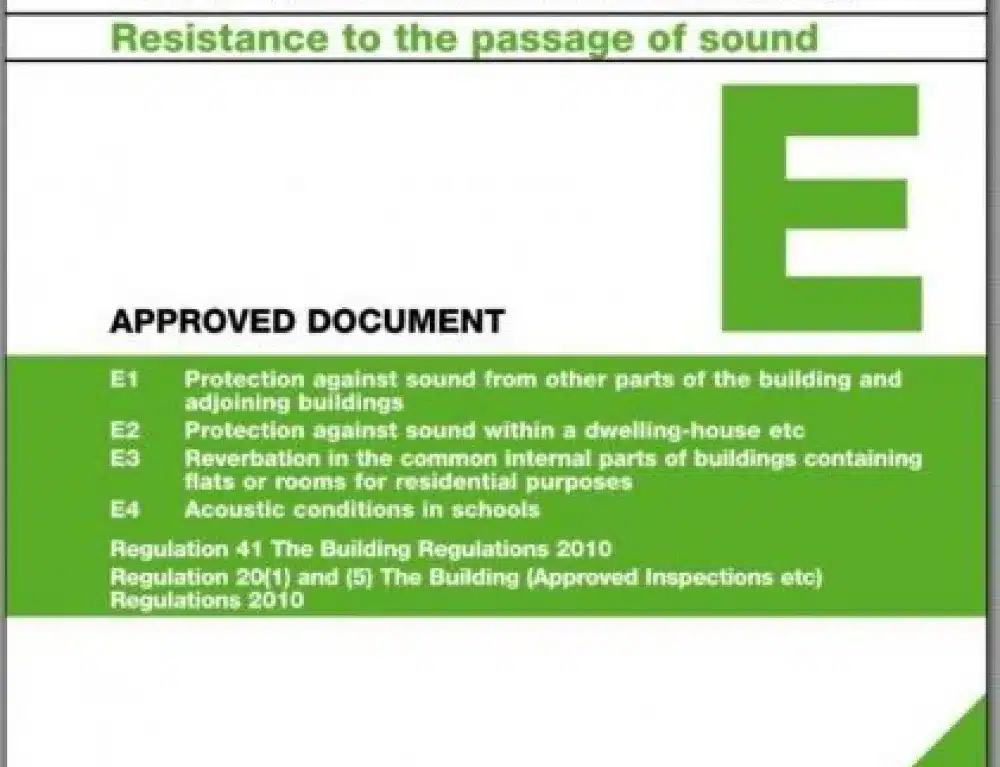We work with contractors to assess the suitability of any proposed on-site works and to provide guidance and support to reduce noise and vibration at the neighbouring receptors.
HMO’s and Sound Testing for Part E of the Building Regulations
- April 1, 2019
What is a House in Multiple Occupation (HMO)?
Does Part E of the building regs apply?

Interpretation (Regulation 2) ‘room for residential purposes’ means a room, or suite of rooms, which is not a dwelling house or a flat and which is used by one or more persons to live and sleep and includes a room in a hostel, an hotel, a boarding house, a hall of residence or a residential home, but does no include a room in a hospital or other similar establishment, used for patient accommodation.
When rooms are defined as rooms for residential purposes the requirement E1 of Part E of the building regulations applies.
E1. Dwelling-houses, flats and rooms for residential purposes shall be designed and constructed in such a way that they provide reasonable resistance to sound from other parts of the same building and from adjoining buildings.
What do the Department for Communities and Local Government (DCLG) say?
The following extract is taken from the DCLG frequently asked questions
Should rooms in Houses in Multiple Occupation (HMO) be treated as Rooms for Residential Purposes?
There is no single answer to this question. The term “House in Multiple Occupation” (HMO) is defined in the Housing Act 2004, and a wide range of premises will fall within the definition. Many of these premises will contain rooms that would also meet the definition of a room for residential purposes given in regulation 2(1) of the Building Regulations; however there are others that will not. Each case should therefore be considered on its own merits.
When deciding whether a room or a suite or rooms is a room for residential purposes, the list of establishments in which rooms for residential purposes may be found, which is given in the definition in regulation 2(1), provides useful guidance. It states that a room or suite of rooms, used by one or more persons to live and sleep, in a hostel, hotel, boarding house, hall of residence or residential home is included in the definition of room for residential purposes. Consequently rooms or suites of rooms used by one or more persons to live and sleep in HMOs used for those purposes, or in HMOs which have a substantially similar use, are likely to be rooms for residential purposes, although it is necessary to carefully consider each case individually.
Rooms or suites of rooms in HMOs which are not hotels, hostels, boarding houses, halls of residence, residential homes or similar are therefore unlikely to be rooms for residential purposes as defined in the Building Regulations. It is not possible to give definitive guidance, but it is unlikely for example that bedrooms in a HMO which consists of a single family dwelling-house which is shared by a small group of students could be regarded as rooms for residential purposes.
So as you can see there is a degree of ambiguity in how HMO’s and Sound Testing should be approached!
What we have experienced?
We have worked on numerous projects with HMO’s and the level of service dictated by the Building Control Officer requested has varied quite dramatically. We have been requested to provide the following level of services in order to sign the development off:
- Sound Insulation Design Advice only; We have bee instructed to simply provide sound insulation design advice by the Building Inspector in order to ensure the developer is undertaking best practical means to achieve the minimum requirements of Part E of the building regulations. But no sound testing was requested on completion.
- Limited Scope of Testing; In some instance the Building Inspector has defined ‘High Risk’ areas that require acoustically design and testing to achieve Part of the building regulations. These are typically separating walls and floors between communal areas such as Living Rooms/Kitchens to Bedrooms.
- Full Sound Testing: In most instances we are asked to design and sound test all separating walls and floors in accordance with Part E of the building regulations. l
- No Testing; On some occasions Part E of the building regulations has been disregarded entirely.
What we would advise?
In all instances the correct approach is to ensure all party walls and floors are designed and tested to achieve the requirements of Part E of the building regulations. Whilst the cost of the development will increase, the benefit of improved sound insulation in HMO’s will pay dividends in the long term through tenants having a more amenable environment to live in and thus they will be more likely to stay in the HMO longer.
As we have found multiple different approaches to HMO’s and Sound Testing it is imperative to consult your Building Inspector early to ensure you are achieving the standards that they require and don’t have a sound test requested at the end of a project when the acoustic measured have not been included in the design.
How can we help?
We listen to our clients’ needs and present them with practical, cost-effective solutions. This means that we offer a truly bespoke acoustic consultancy service for prices that are considered among the most competitive in the industry. NOVA Acoustics Ltd places a team of highly skilled, qualified and experienced acoustic consultants at our client’s full disposable; this is combined with the latest equipment, technological insights and expert guidance and recommendation, to ensure that clients are getting a guaranteed quality service every time they decide to get in touch.
We would love to hear from you so get in touch now!
Construction Noise: A Common Source of Environmental Noise Pollution
Challenges in Monitoring Construction Noise
Monitoring construction noise poses unique challenges due to the dynamic nature of construction sites and the varying types of noise generated. Some of the key challenges include:
1. Site Variability: Construction sites are dynamic, with different phases and activities occurring at different times. Monitoring equipment must be flexible enough to capture noise variations throughout the construction process.
2. Noise Source Identification: Construction noise can emanate from multiple sources simultaneously, making it challenging to identify and measure individual noise contributions accurately. Specialized monitoring techniques and equipment are required to differentiate noise sources effectively.
3. Ambient Noise Interference: Construction sites are often located in urban areas with existing background noise. Isolating and measuring the specific noise generated by construction activities amidst the surrounding ambient noise can be a complex task.
A construction noise and vibration impact assessment and construction noise management plan can assist with planning any noise and vibration monitoring requirements you have.
Section 61: Regulating Construction Noise
To address the adverse effects of construction noise on communities, many jurisdictions have implemented regulations and guidelines. Section 61 (or similar regulations) typically outlines permissible noise limits, construction hours, and mitigation measures for construction sites. These regulations often require construction companies to undertake environmental noise monitoring and maintain records to ensure compliance.
Key Provisions of Section 61. Section 61, or equivalent regulations, typically include the following provisions:
1. Permissible Noise Levels: Defines the maximum allowable noise levels during specific time periods, such as daytime, evening, and nighttime, to protect the well-being of nearby residents.
2. Construction Hours: Specifies the permitted construction hours to minimize disturbances during sensitive periods, such as nighttime or weekends.
3. Mitigation Measures: Outlines the steps that construction companies must take to mitigate noise, such as using noise barriers, employing quieter equipment, or implementing best practices for noise control.
4. Monitoring and Reporting: Requires construction companies to conduct regular noise monitoring using calibrated equipment and maintain records of noise levels to demonstrate compliance with the regulations.
Environmental noise monitoring, particularly in the context of construction noise, is crucial for ensuring the well-being of communities and maintaining a sustainable urban environment. By adhering to regulations like Section 61, construction companies can play an active role in reducing noise pollution, implementing mitigation measures, and promoting harmonious coexistence with neighboring communities. With effective monitoring, enforcement, and collaboration between regulatory bodies, construction companies, and communities, we can create a healthier and more peaceful living environment for everyone.
We provide Noise, Vibration and Dust Monitoring services to ensure you are demonstrating compliance with the relevant regulations.
Recent posts
As urban areas continue to expand and human activities thrive, environmental noise pollution has become a significant concern.
Poor Sound Insulation is an issue that plagues many houses both small and large, through the development of noisy hobbies such as gaming systems, drum kits or food processors, or simply poorly soundproofed properties.










